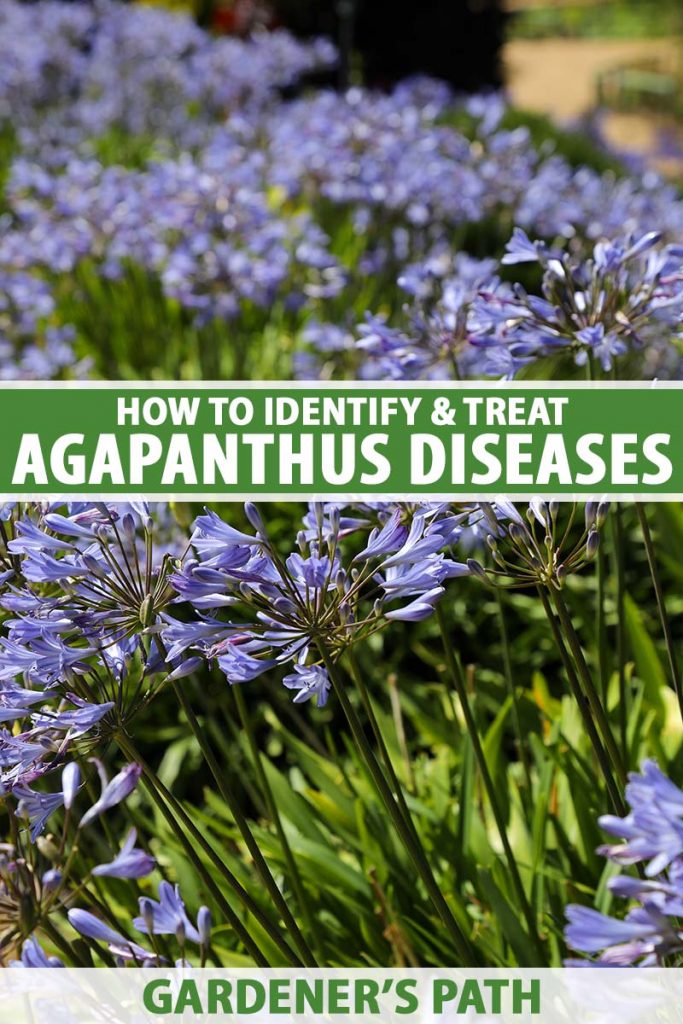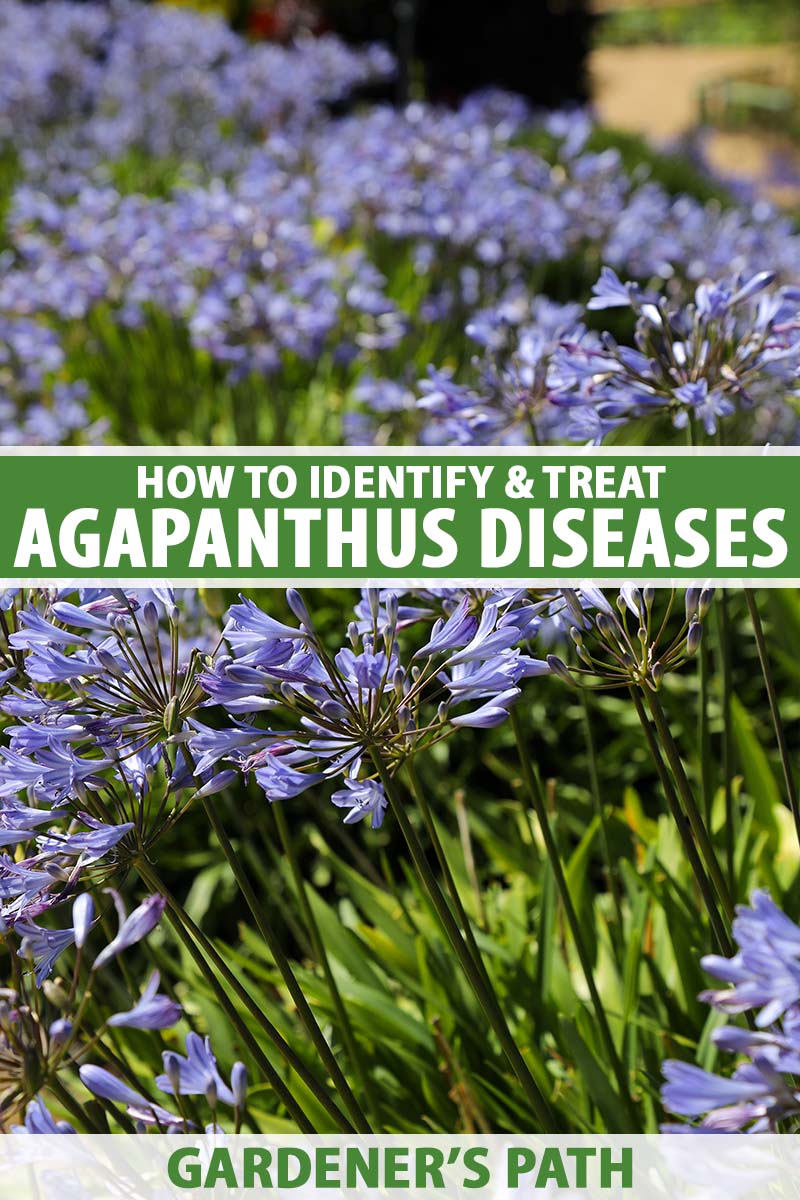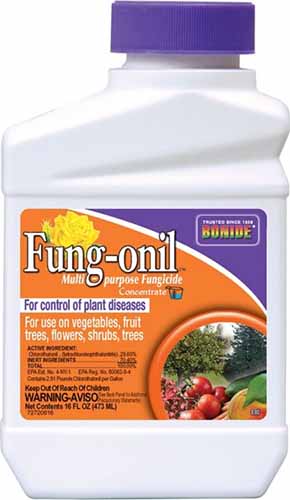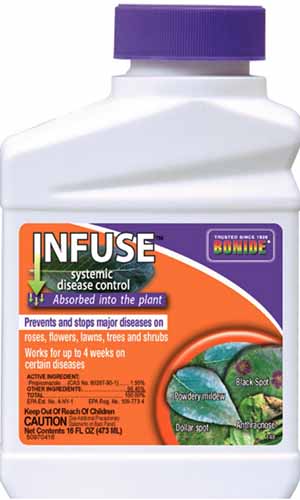I still vividly remember my excitement on my first trip to California when I saw them growing outside, with their rounded flower heads and long, strap-like leaves. And now, I am fortunate to live in Zone 9b, where I can grow them in my own garden! We link to vendors to help you find relevant products. If you buy from one of our links, we may earn a commission. So resistant, in fact, that if you search the scientific literature for common pathogens that infect them, you mostly find articles relating to their production of antifungal chemicals. In their native South Africa, scientists study extracts from agapanthus plants as potential controls for a variety of plant diseases. In our guide to growing agapanthus, we cover how to cultivate these easy-care ornamentals in the garden. They thrive in a full sun location with organically-rich, well-drained soil. But what happens when things go wrong? Certain growing conditions can predispose agapanthus to a few diseases, and in this article I will cover five of the most common:
1. Anthracnose
If you are in the habit of reading about plant diseases, there is a good chance you are familiar with anthracnose – a serious disease in plants such as hydrangeas, caused by an ubiquitous worldwide group of pathogens in the Colletotrichum genus. These fungi are very common in humid temperate climates – waiting to strike when environmental conditions are right. Overwatering and too much moisture on the leaves can contribute to this infection. Symptoms include brown spots on the leaves that can sometimes have purple edges. In the case of a severe infection, the spots turn black as the tissue dies and foliage can turn yellow, eventually dropping from the plants. Since the fungus spreads easily via infected plant tissue, immediately prune the affected foliage and dispose of the debris somewhere other than on your compost pile! Remember to disinfect your pruning shears as you go to prevent spreading the infection to other plants. You can use 70 percent rubbing alcohol or 10 percent bleach. Applying a layer of mulch can prevent the spores from splashing from the ground onto the foliage of your plants. If your plants have a serious infection, with a large amount of foliage affected, you may need to apply a fungicide, since the disease could potentially kill your plant – or spread to other ornamentals. It is a good idea to alternate the fungicide that you use, so the fungi won’t develop resistance. Learn more about how to rotate fungicides in our guide.
Bonide Fung-onil Concentrate If you want to order online, you can buy chlorothalonil from Tractor Supply as Bonide Fung-onil Concentrate. You will need to spray the plants every 10-14 days, according to package instructions. An organic option for fungal control is a copper-based fungicide.
Bonide Copper Fungicide Arbico Organics offers a current formulation of the traditional Bordeaux mixture as Bonide Copper Fungicide Dust. Apply every week to 10 days during dry conditions, according to package instructions.
2. Gray Mold
Also known as Botrytis blight, the dreaded gray mold (Botrytis cinerea) is a potentially devastating disease, typically appearing when the weather is cool and humid. It usually only affects agapanthus plants that are in shady locations and those that are overwatered, or planted in soil that doesn’t drain well. This pathogen is widespread and has an enormous host range, so there is a good chance that it is present in your plant’s environment if you live in a humid location. Symptoms start as a gray, fuzzy mold on the leaves, flower stalks, flowers, and buds. The fungus forms a film over the top of the infected portion, and the leaves may become slimy and eventually fall off. Your first step is to remove all of the infected tissue and purge it from your garden, so it won’t spread spores. Unfortunately, this fungus is known for rapidly developing resistance to fungicides – often in the same season that a new chemical is introduced. As soon as you notice symptoms, you’ll need to treat your plants with a fungicide – but first you should check with your local extension service to find out what fungicides are recommended for use in your area. The University of Florida’s IFAS Extension recommends growing resistant varieties of agapanthus if you live in a humid climate such as Florida.
3. Leaf Spot
A number of fungi throughout the world have been found to cause leaf spots on agapanthus plants. While these are not typically fatal, they can cause unsightly discoloration on the foliage. One of the more common fungal infections is red leaf blotch disease, caused by Stagonospora curtisii (Phoma narcissi). This fungus is primarily known as a pathogen of Hippeastrum amaryllis plants grown in gardens, but it can also infect agapanthus. It causes streaks of red or reddish-brown blotches on the leaves. This fungicide is absorbed by the roots, protecting the plant systemically. Apply according to package instructions when you first see signs of the disease.
Bonide Infuse™ Systemic Disease Control You can buy thiophanate-methyl as Bonide Infuse™ Systemic Disease Control from Home Depot. Repeat every 14 days as needed. Other species of fungi that have been found to cause leaf spots on agapanthus plants throughout the world include:
Macrophoma agapanthus Phomopsis agapanthi sp. nov Septoria agapanthi sp nov Devriesia agapanthi
Most of these will resolve on their own without any need for treatment, but you can choose to apply a fungicide such as chlorothalonil (see our recommendation above).
4. Powdery Mildew
As with many other plants, agapanthus that is grown in shady spots may contract powdery mildew, known for the white, powdery coating it causes on the leaves. Caused by hundreds of different species of fungi, powdery mildew can be a devastating disease on some plants, but thankfully it is not a common problem on agapanthus. Fortunately, there are a number of home remedies you can use to treat this disorder.
5. Root Rot
A number of different fungi and water molds (Oomycetes) can cause root rot. Fortunately, you can usually preempt this disorder by ensuring that your plants have good drainage and are not overwatered. Saturated, waterlogged soil deprives the roots of oxygen, and in their weakened state, they are vulnerable to attack. Plants affected by root rot may display stunted growth or wilting foliage, but in many cases they won’t present any symptoms until it’s too late to save them. You may not know your agapanthus is infected until it collapses and dies. Dead plants should be uprooted and discarded.
Additionally, it grows so well in some locations that it is sometimes considered a weed! You can avoid most diseases by planting in full sun, providing good drainage, and watering at the base of the plant instead of on the leaves. However, if you live in a humid area, you may have to plant varieties that are resistant to gray mold. Have you battled a disease on your agapanthus plants? If so, let us know in the comments section below! And for more information about growing agapanthus in your garden, check out these guides next:
25 of the Best Agapanthus Varieties for Your Garden Tips for Growing Agapanthus Flowers in Containers How to Care for Agapanthus Plants in Winter
© Ask the Experts, LLC. ALL RIGHTS RESERVED. See our TOS for more details. Product photos via Arbico Organics, Home Depot, and Tractor Supply. Uncredited photos: Shutterstock. With additional writing and editing by Clare Groom.





